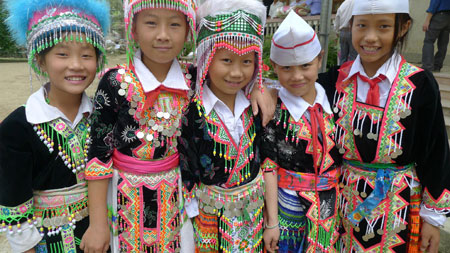
White H’mong girls
For the H’mong, in fact, clothes do make the man – or woman, in this case. They are divided into several subgroups, but the four major ones are White, Red, Black, and Flower H’mong, a reference to the colors of their women’s clothes.
For ages the H’mong women have been making their families’ clothes by hand. In the past girls used to be taught weaving, embroidering, and sewing at seven or eight, skills that were considered a basic criterion to judge their character and find a good husband.
“You are beautiful but bad at weaving means you are still unattractive,” H’mong mothers often tell their daughters.
By the time she gets married (at 15-18) a girl should have made around 10 dresses to take with her to her husband’s family.
She will continue to weave and embroider for the rest of her life.
H’mong women can be seen dividing or knotting a roll of linen fiber even when walking to the market or sitting around with friends.
“We grow flax for our clothes,” Vang Seo Su of Quan Ba District, Ha Giang Province, says.
“If the Thai have cotton, we have linen. Others recognize us because we wear linen. And when we die our children will have to dress us in linen clothes so that our ancestors in heaven can recognize us.”
Su says making a skirt or a jacket involves a lot of steps.
“It takes around three months for the flax plants to become ready for harvest,” she says.
“Then we dry the plants and take the fibers from their stem. We must crush the stem and boil and tear it into thin strips. Now we have the white fibers for weaving.”
Dyeing is another time-consuming process that requires patience and experience. The H’mong use natural substances such as indigo, saffron, and betel to color their clothes.
The Flower and the Red H’mong are famous for their indigo batik technique. They dip a feather or cotton in wax and draw patterns on the white cloth, dye the cloth with indigo, and soak in hot water. The wax melts, leaving white patterns on the dark-blue background.
After the dyeing is finished the next step is embroidering and sewing to make a complete suit.
A traditional H’mong woman’s suit comprises of a jacket, a pleated skirt, a waistband, an apron, leggings, and hat. But different subgroups, or even the same group living in different places, design their clothes in different styles and colors.
The White H'mong in Lai Chau Province usually wear a white pleated skirt under a black apron and black jacket and a plain black headscarf decorated with tassels. But in Tuyen Quang, Bac Kan, and Cao Bang, they have switched to black trousers.
The Black H'mong live mainly in Sapa District in Lao Cai Province. They get their name because they are dressed in dark clothes that are dyed in indigo. A suit includes a pleated skirt, a jacket, a long waistcoat, leggings, and a pillbox hat.
Red H’mong (also called Red Dao) women dress in black as well but wrap their hair in a red scarf decorated with accessories.
Their traditional costume features a pleated indigo batik skirt worn under a black apron with a red waistband and a black jacket with large embroidered lapel panels at the front. They are mainly seen in Lai Chau.
The Flower H'mong are the most colorful of the lot. They wear a colorful embroidered calf-length skirt together with an embroidered jacket that can be black, blue, or green. Visitors can see Flower H'mong women when they go to Bac Ha Market held on Sundays in Lao Cai. They also live in Yen Bai and Son La provinces.
While the women’s costumes are a splash of colors and patterns, the men wear simpler clothes in black with little embroidery. Their suit comprises of a short, tight jacket and short, loose trousers that allow them free movement for their daily chores.
Their mother and sisters make the clothes for them first, then it is the girlfriend and wife.
The costume that sings
The H’mong attire not only catches the eye but also the ear. In the field, on the road, or at the market, a H’mong woman is easily noticed by the jingle from her clothes. It comes from all the accessories and jewelry she wears.
Besides all the colors and patterns, the H’mong also like to decorate their clothes with metal coins that are carefully attached to waistbands, leggings, hats with colorful strings. The coins are normally made of cheap metal, but are sometimes in silver and have French-era patterns. They are available at all local markets.
When Tet nears, H’mong girls make waistbands with many coins to decorate their dresses. A family’s economic status can be gauged from the number of coins in their dresses.
Moc Chau, Sa Pa, Sin Ho, and Dong Van are well-known for their magnificent landscapes alright, but are likely to lose half their charm without the colorful H’mong.
However, visitors should not be surprised to return here just after the New Year and see the colorful dresses and jingling noises disappear.
This is a tragic casualty of economic development - H’mong as well as other ethnic groups are increasingly opting to wear jeans and shirts instead of spending time at their looms.

Leave your comment on this story